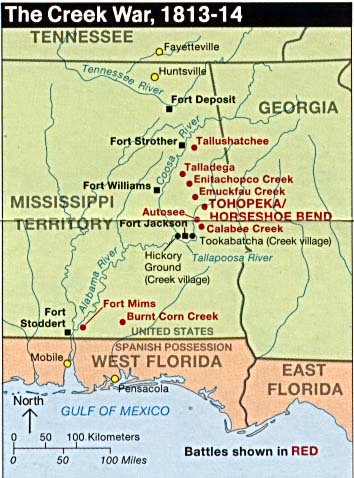|
Sehoy Marchand
Sehoy, or Sehoy I (died ca. 1730), was an 18th-century matriarch of the Muscogee Confederacy and a member of the Wind clan. She established a dynasty that became influential in the political and economic history of her nation and its relationship with the United States. Because inheritance and property within the confederacy were controlled matrilineally in early Muscogee society, her daughters and their descendants became influential in shaping tribal membership and relations with people they enslaved. In Muscogee culture, tribal affiliation was defined by clan membership and matrilineal descent. If the mother was part of a tribe, her children would also be part of that tribe, regardless of the father's ethnicity or citizenship. Some of her male descendants shaped policy with the United States through treaty-making and through tribal leadership. Biography Sehoy was a Muscogee woman of the Wind clan. Amos J. Wright, who analyzed for over two decades the genealogical history ... [...More Info...] [...Related Items...] OR: [Wikipedia] [Google] [Baidu] |
Muscogee Confederacy
The Muscogee, also known as the Mvskoke, Muscogee Creek, and the Muscogee Creek Confederacy ( in the Muscogee language), are a group of related indigenous (Native American) peoples of the Southeastern WoodlandsTranscribed documents Sequoyah Research Center and the American Native Press Archives in the . Their original homelands are in what now comprises southern , much of , western |
Tallapoosa River
The Tallapoosa River runs U.S. Geological Survey. National Hydrography Dataset high-resolution flowline dataThe National Map, accessed April 27, 2011 from the southern end of the Appalachian Mountains in Georgia, United States, southward and westward into the Appalachian foothills in Alabama. It is formed by the confluence of McClendon Creek and Mud Creek in Paulding County, Georgia. Lake Martin at Dadeville, Alabama is a large and popular water recreation area formed by a dam on the river. The Tallapoosa joins the Coosa River about northeast of Montgomery near Wetumpka (in Elmore County) to form the Alabama River. There are four hydroelectric dams on the Tallapoosa: Yates, Thurlow, Martin and Harris dams. They are important sources of electricity generation for Alabama Power (a unit of the Southern Company) and recreation for the public. Description The Tallapoosa River, especially its lower course, was a major population center of the Creek Indians before the early ... [...More Info...] [...Related Items...] OR: [Wikipedia] [Google] [Baidu] |
Peter McQueen
Peter McQueen (c. 1780 – 1820) was a Creek chief, prophet, trader and warrior from ''Talisi'' ( Tallassee, among the Upper Towns in present-day Alabama.) He was one of the young men known as Red Sticks, who became a prophet for expulsion of the European Americans from Creek territory and a revival of traditional practices. The Red Sticks attracted a majority of the population in the Upper Towns in the early nineteenth century. From open conflict with the Lower Towns in the Creek War, the Red Sticks were drawn into conflict with the United States after being attacked by territorial militia. The Red Sticks were defeated by Colonel Andrew Jackson with state militias, Creek and Cherokee warriors at Horseshoe Bend in 1814. McQueen survived to retreat into Florida, along with other Creek warriors. There he joined the recently formed Seminole and continued resistance to United States forces during the First Seminole War. Early life and education Peter McQueen was the son of a hi ... [...More Info...] [...Related Items...] OR: [Wikipedia] [Google] [Baidu] |
Creek War
The Creek War (1813–1814), also known as the Red Stick War and the Creek Civil War, was a regional war between opposing Indigenous American Creek factions, European empires and the United States, taking place largely in modern-day Alabama and along the Gulf Coast. The major conflicts of the war took place between state militia units and the " Red Stick" Creeks. The United States government formed an alliance with the Choctaw Nation and Cherokee Nation (the traditional enemies of the Creeks), along with the remaining Creeks to put the rebellion down. According to historian John K. Mahon, the Creek War "was as much a civil war among Creeks as between red and white, and it pointed up the separation of Creeks and Seminoles". The war was also part of the centuries-long American Indian Wars. It is usually considered part of the War of 1812 because it was influenced by Tecumseh's War in the Old Northwest, was concurrent with the American-British portion of the war and involved m ... [...More Info...] [...Related Items...] OR: [Wikipedia] [Google] [Baidu] |
Red Sticks
Red Sticks (also Redsticks, Batons Rouges, or Red Clubs), the name deriving from the red-painted war clubs of some Native American Creeks—refers to an early 19th-century traditionalist faction of these people in the American Southeast. Made up mostly of Creek of the Upper Towns that supported traditional leadership and culture, as well as the preservation of communal land for cultivation and hunting, the Red Sticks arose at a time of increasing pressure on Creek territory by European-American settlers. Creek of the Lower Towns were closer to the settlers, had more mixed-race families, and had already been forced to make land cessions to the Americans. In this context, the Red Sticks led a resistance movement against European-American encroachment and assimilation, tensions that culminated in the outbreak of the Creek War in 1813. Initially a civil war among the Creek, the conflict drew in United States state forces while the nation was already engaged in the War of 1812 agains ... [...More Info...] [...Related Items...] OR: [Wikipedia] [Google] [Baidu] |
Sophia Durant
Sophia Durant (ca. 1752 – ca. 1813/1831) was a Koasati Native American plantation owner, who served as the speaker, interpreter, and translator for her brother, Alexander McGillivray, a leader in the Muscogee Confederacy. Durant was born to a mixed-race Native mother and Scottish father in the mid-18th century on Muscogee Confederacy lands in what is now Elmore County, Alabama. Taught reading and writing, she influenced the political and economic development of her people. After managing with her husband, probably a mixed-race Black/Native man, her father's estates in Savannah, Georgia, for three or four years, Durant returned to Muscogee territory and established the first cattle plantation in the Tensaw District of the nation. She also managed communal lands as part of her matriarchal inheritance at Hickory Ground and operated as a middleman between Anglo and Native traders. Although she was one of the largest slaveholders in the nation, she often treated her slaves as part ... [...More Info...] [...Related Items...] OR: [Wikipedia] [Google] [Baidu] |
Alexander McGillivray
Alexander McGillivray, also known as ''Hoboi-Hili-Miko'' (December 15, 1750February 17, 1793), was a Muscogee (Creek) leader. The son of a Muscogee mother and a Scottish father, he had skills no other Creek of his day had: he was not only literate but educated, and he knew the "white" world and merchandise trading well. These gave him prestige, especially with European-Americans, who were glad to finally find a Creek leader they could talk to and deal with. (Prior to contact with Europeans, the Creek did not have leaders or rulers in the European sense.) He used his role as link between the two worlds to his advantage, not always fairly, and became the richest Creek of his time. McGillivray was literate and his "voluminous" correspondence has survived. In many cases his letters are the only source for events in his life, and they naturally present him in a very good light. Recent historians have taken issue with the heroic status he had in earlier histories. McGillivray's stat ... [...More Info...] [...Related Items...] OR: [Wikipedia] [Google] [Baidu] |
William Weatherford
William Weatherford, also known after his death as Red Eagle (ca. 1765 – March 24, 1824), was a Creek chief of the Upper Creek towns who led many of the Red Sticks actions in the Creek War (1813–1814) against Lower Creek towns and against allied forces of the United States. One of many mixed-race descendants of Southeast Indians who intermarried with European traders and later colonial settlers, William Weatherford was of mixed Creek, French, and Scots ancestry. He was raised as a Creek in the matrilineal nation and achieved his power in it, through his mother's prominent Wind Clan (as well as his father's trading connections). After the war, he rebuilt his wealth as a slaveholding planter in lower Monroe County, Alabama. Early life and education William Weatherford was born in 1781 (Griffith Jr. analysis), near the Upper Creek towns of Coosauda. Availableonline/ref>Griffith's analysis of Weatherford's date of birth is based on the death of his mother's first husband in the ... [...More Info...] [...Related Items...] OR: [Wikipedia] [Google] [Baidu] |
Sehoy Weatherford
Sehoy, or Sehoy I (died ca. 1730), was an 18th-century matriarch of the Muscogee Confederacy and a member of the Wind clan. She established a dynasty that became influential in the political and economic history of her nation and its relationship with the United States. Because inheritance and property within the confederacy were controlled matrilineally in early Muscogee society, her daughters and their descendants became influential in shaping tribal membership and relations with people they enslaved. In Muscogee culture, tribal affiliation was defined by clan membership and matrilineal descent. If the mother was part of a tribe, her children would also be part of that tribe, regardless of the father's ethnicity or citizenship. Some of her male descendants shaped policy with the United States through treaty-making and through tribal leadership. Biography Sehoy was a Muscogee woman of the Wind clan. Amos J. Wright, who analyzed for over two decades the genealogical history ... [...More Info...] [...Related Items...] OR: [Wikipedia] [Google] [Baidu] |
Red Shoes (Muskogean Chief)
Red Shoes (ca. 1720 - 1783) was a Muskogean leader of the Tuskegee people in the 18th century. He primarily lived in modern Alabama near Tuskegee at the forks of the Alabama River, but his influence extended well into modern Mississippi. Red Shoes was the son of a Koasati leader also known as Red Shoes and his wife Sehoy. Since lineage among the Muscogee Confederacy was traced matrilineally, Red Shoes, like his mother, was part of the Wind Clan. His parents also had a daughter together, who would have been his full sister. His half-sister, Sehoy Marchand, daughter of Jean Baptiste Louis DeCourtel Marchand was first married to Angus or August McPherson, with whom she had two children, Sehoy McPherson (Sehoy III) and Malcolm McPherson. She later married Lachlan McGillivray and had three more children, Alexander, Sophia Sophia means "wisdom" in Greek. It may refer to: *Sophia (wisdom) *Sophia (Gnosticism) *Sophia (given name) Places *Niulakita or Sophia, an island of Tuvalu * ... [...More Info...] [...Related Items...] OR: [Wikipedia] [Google] [Baidu] |
Sehoy Marchand
Sehoy, or Sehoy I (died ca. 1730), was an 18th-century matriarch of the Muscogee Confederacy and a member of the Wind clan. She established a dynasty that became influential in the political and economic history of her nation and its relationship with the United States. Because inheritance and property within the confederacy were controlled matrilineally in early Muscogee society, her daughters and their descendants became influential in shaping tribal membership and relations with people they enslaved. In Muscogee culture, tribal affiliation was defined by clan membership and matrilineal descent. If the mother was part of a tribe, her children would also be part of that tribe, regardless of the father's ethnicity or citizenship. Some of her male descendants shaped policy with the United States through treaty-making and through tribal leadership. Biography Sehoy was a Muscogee woman of the Wind clan. Amos J. Wright, who analyzed for over two decades the genealogical history ... [...More Info...] [...Related Items...] OR: [Wikipedia] [Google] [Baidu] |


.png)

